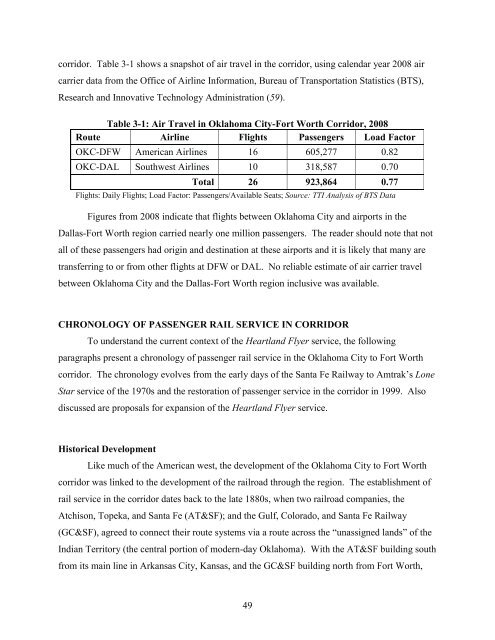Measuring the Benefits of Intercity Passenger Rail: A Study
Measuring the Benefits of Intercity Passenger Rail: A Study
Measuring the Benefits of Intercity Passenger Rail: A Study
You also want an ePaper? Increase the reach of your titles
YUMPU automatically turns print PDFs into web optimized ePapers that Google loves.
corridor. Table 3-1 shows a snapshot <strong>of</strong> air travel in <strong>the</strong> corridor, using calendar year 2008 air<br />
carrier data from <strong>the</strong> Office <strong>of</strong> Airline Information, Bureau <strong>of</strong> Transportation Statistics (BTS),<br />
Research and Innovative Technology Administration (59).<br />
Table 3-1: Air Travel in Oklahoma City-Fort Worth Corridor, 2008<br />
Route Airline Flights <strong>Passenger</strong>s Load Factor<br />
OKC-DFW American Airlines 16 605,277 0.82<br />
OKC-DAL Southwest Airlines 10 318,587 0.70<br />
Total 26 923,864 0.77<br />
Flights: Daily Flights; Load Factor: <strong>Passenger</strong>s/Available Seats; Source: TTI Analysis <strong>of</strong> BTS Data<br />
Figures from 2008 indicate that flights between Oklahoma City and airports in <strong>the</strong><br />
Dallas-Fort Worth region carried nearly one million passengers. The reader should note that not<br />
all <strong>of</strong> <strong>the</strong>se passengers had origin and destination at <strong>the</strong>se airports and it is likely that many are<br />
transferring to or from o<strong>the</strong>r flights at DFW or DAL. No reliable estimate <strong>of</strong> air carrier travel<br />
between Oklahoma City and <strong>the</strong> Dallas-Fort Worth region inclusive was available.<br />
CHRONOLOGY OF PASSENGER RAIL SERVICE IN CORRIDOR<br />
To understand <strong>the</strong> current context <strong>of</strong> <strong>the</strong> Heartland Flyer service, <strong>the</strong> following<br />
paragraphs present a chronology <strong>of</strong> passenger rail service in <strong>the</strong> Oklahoma City to Fort Worth<br />
corridor. The chronology evolves from <strong>the</strong> early days <strong>of</strong> <strong>the</strong> Santa Fe <strong>Rail</strong>way to Amtrak’s Lone<br />
Star service <strong>of</strong> <strong>the</strong> 1970s and <strong>the</strong> restoration <strong>of</strong> passenger service in <strong>the</strong> corridor in 1999. Also<br />
discussed are proposals for expansion <strong>of</strong> <strong>the</strong> Heartland Flyer service.<br />
Historical Development<br />
Like much <strong>of</strong> <strong>the</strong> American west, <strong>the</strong> development <strong>of</strong> <strong>the</strong> Oklahoma City to Fort Worth<br />
corridor was linked to <strong>the</strong> development <strong>of</strong> <strong>the</strong> railroad through <strong>the</strong> region. The establishment <strong>of</strong><br />
rail service in <strong>the</strong> corridor dates back to <strong>the</strong> late 1880s, when two railroad companies, <strong>the</strong><br />
Atchison, Topeka, and Santa Fe (AT&SF); and <strong>the</strong> Gulf, Colorado, and Santa Fe <strong>Rail</strong>way<br />
(GC&SF), agreed to connect <strong>the</strong>ir route systems via a route across <strong>the</strong> “unassigned lands” <strong>of</strong> <strong>the</strong><br />
Indian Territory (<strong>the</strong> central portion <strong>of</strong> modern-day Oklahoma). With <strong>the</strong> AT&SF building south<br />
from its main line in Arkansas City, Kansas, and <strong>the</strong> GC&SF building north from Fort Worth,<br />
49
















